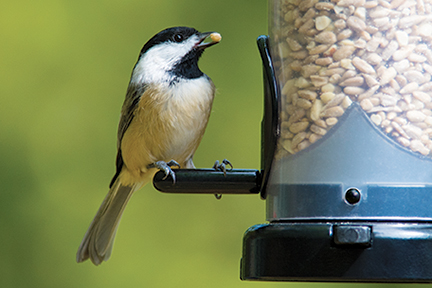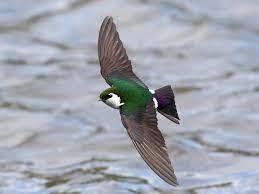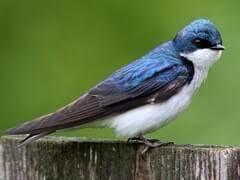Bird of the Month: Swallows
Swallows are passerine or perching birds that belong to the family Hirundinidae which are characterized by their adaptation to aerial feeding. Swallows have slender, streamlined bodies and long, pointed wings which allow great maneuverability and endurance as well as frequent periods of gliding. Their body shape allows for very effective flight. Swallows usually forage at 18 - 24 miles per hour although they can reach speeds of 31 - 37 miles per hour when traveling.
Each wing has nine primary feathers and the tail has twelve feathers and may be deeply forked, indented or square-ended. Their long tails increase aerial agility.
Swallows have short legs and their feet are adapted for perching rather than walking.
In general, swallows are insect eaters with some species occasionally eating fruit during migration.
Swallows nest in cavities, burrows or build mud nests. Many species of swallows nest in large colonies.
Pairs of mated swallows are monogamous. The nesting site is defended vigorously during breeding season. Migratory species often return to the same breeding area each year and may select the same nesting site. First year breeders generally select a nesting site close to where they were born and raised. The male swallow contributes to parental care more than any other passerine bird.
Swallows usually lay four to five eggs. The chicks hatch naked with closed eyes that won't open for up to ten days.
In our part of the world we get to enjoy five different swallows regularly. Tree Swallows, Northern Rough-winged Swallows, Violet-green Swallows, Barn Swallows and Cliff Swallows. Below are some helpful identification tips and fun facts about our swallows.
Tree Swallows are iridescent blue-green on top and white underneath. They have broad, triangular wings and a short, slightly-notched tail. They will readily use nesting boxes and are found around marshes and open fields usually near water. After breeding season, the Tree Swallows congregate into enormous flocks and night roosts sometimes numbering in the hundreds of thousands.
Barn Swallows are glistening cobalt blue above and cinnamon-buff below with a dark breast band, and a rusty throat and forehead. There is a white spot near the tip of each tail feather. They have long, dark, pointed wings and a forked tail. They are found in open habitat with buildings, bridges or culverts for nesting. Legend has it that the Barn Swallow got its forked tail because it stole fire from the gods to give to people. An angry god hurled a fireball at the swallow singeing away its middle tail feathers.
Violet-green Swallows are a brilliant, iridescent purple-green above with white below extending above the eye. It is fairly petite, with long wings and a slightly-notched tail. It is found in open woodlands and only in the American west. A pair of Violet-green Swallows were observed assisting a pair of Western Bluebirds in raising young. The swallows guarded the nest and tended the bluebird nestlings. After the bluedbirds fledged, the swallows used the nest for their own brood.
Northern Rough-winged Swallows are stocky birds, plain brown above and whitish below. They have a square tail and long, pointed wings. They get their name from the outer wing feathers which have small hooks or points on their outer edges.
Cliff Swallows have a bluish black head with a light forehead spot. The back is blue-black with streaks of white. The underparts are whitish. The wings are long and pointed and the tail is square with a rusty buff rump. Cliff Swallows can nest solitarily but usually nest in colonies.



